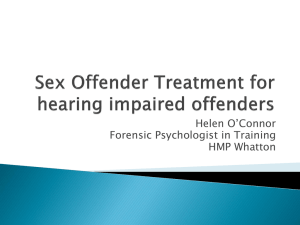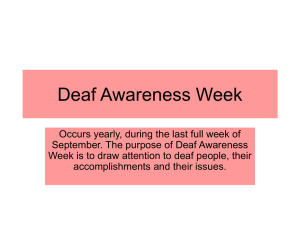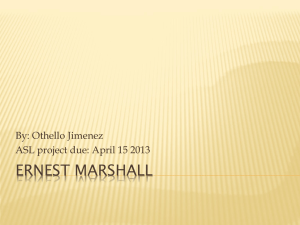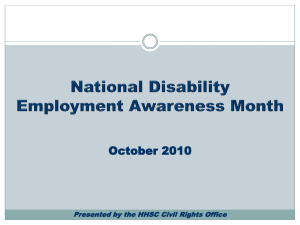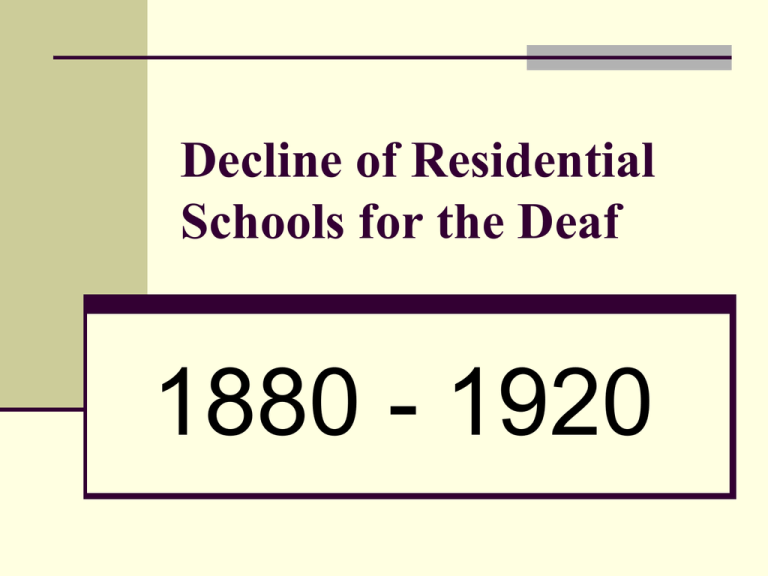
Decline of Residential
Schools for the Deaf
1880 - 1920
AGB tried to reach the
Public than teachers of
deaf children.
They built broad public
support for their policies
and beliefs.
In 1882, only 7.5% of 7,000 taught orally.
In 1900, 47%
In 1905, over 50% first time
In 1919, nearly 80%
Denominational Schools
The Catholic Church had been interested in
educating children for a long time.
Father Timon, who later became a bishop in
Buffalo, New York, was very much interested in
helping deaf people. He and two French nuns
started a school for deaf children in Saint Louis,
Missouri. That school is still there.
Later, Father Timon invited the same nuns to
open a school in New York. They started the
Saint Mary’s School for the Deaf in Buffalo,
New York. They opened their school in 1859 in
three tiny cottages.
In 1837, two sisters of St. Joseph from Lyon, France
Met by the Rev. John Timon in New Orleans
Took the boat up the Mississippi River to Saint
Louis in Missouri
One year later, they mastered enough English
Opened at the convent in Carondelet in the Saint
Louis area
The school called the Mariae Consilia Deaf Mute
Institution
Through a number of name changes and merged
with Saint Joseph’s School for the Deaf in around
1910.
The Sisters of St. Joseph
• In 1859, they opened
the LeCouteuiz St.Mary’s
School for the Deaf in
Buffalo, New York.
The Sisters of Loretto at the Foot of the Cross
By 1840, in Loretto, Ketucky
Began admitting deaf girls to their school
The Sisters were taught by a sister who had
also been trained at a Catholic school for the
deaf in France.
That school was short-lived and closed due to
lack of funds and small attendance.
In 1907, four Catholic
schools for the Deaf in the
State of New York, which
had a deaf population of
about 10,000.
There were 593 children
being cared for.
4,744 children in Catholic
schools for the deaf outside
of the State of New York
• The other Catholic institutions
are almost entirely dependent
upon the charity of religious
sisterhoods.
Detroit, Michigan
The Lutherans in Detroit decided to open an
orphanage, a home for children who do not have
any parents.
Mr. Speckhardt, a minister, was chosen to
manage the orphanage.
Mr. Speckhardt had taught deaf children in
Germany. He accepted two deaf girls into the
orphanage. The news spread all over Michigan.
In a few years, there were twice as many deaf
children as orphans.
In 1874, the orphanage changed its name and
became a school for deaf students.
Northern California
The first state school opened in 1860. It was
started by 23 ladies who wanted to teach
poor and blind children.
They called their new school “The Society for
the Instructing and Maintenance of the
Indigent Deaf and Dumb and Blind.”
After 15 years, a fire destroyed the building,
and a new school was built.
Ephpahatha
Its mission is
to worship the Lord Jesus
1880 in August
National Convention of DeafMutes
held in Cincinnati, Ohio
for three days
For centuries, hearing people had been
trying to help deaf people.
Too often, hearing people also had been
deciding what was best for deaf people.
Deaf people had little chance to express their
views.
The debating and the voting were almost
entirely done by hearing people.
Deaf people felt frustrated by the results.
What was happening in Europe?
We knew that the European deaf
were protesting against the
growth of the pure oral method,
but that these deaf people were
unable to stop that growth.
The American deaf people did not
want that to happen in their
country.
To control their own destinies
To bring the deaf of the different sections in
close contact.
Deaf people were capable to enter all
vocations in life.
A turning inward by the Deaf community in
the face of stress and change.
Deaf people looked to themselves for the
leadership and the strength they would need
to confront an environment.
1880 was an important year.
The National Convention of
Deaf-Mutes was born, and
deaf leaders started to
emerge, but the Milan
Congress made a major
decision that changed the
lives of many deaf children.
In 1883 – Second NAD convention
held in New York City with 174
participants from 18 states;
members decided to raise money
for a statue in honor of Thomas
Hopkins Gallaudet
In 1887 - $13,000 raised for the
Gallaudet memorial statue.
Several organizations of the deaf in America
• Conference of Executives of
American School for the Deaf
• The Convention of American
Instructors of the Deaf
• The Conference of Principles
of American Institutions for the
Deaf
New England Gallaudet
Association of the Deaf
The idea of a national association of the deaf
dates back to 1850.
• gathered in Hartford, Connecticut to pay tribute to Thomas
Hopkins Gallaudet and Laurent Clerc.
• discussed the need for a national association, but agreed
that the idea was impractical.
• Deaf leaders were scattered. Travel was slow and difficult.
• The suggestion of an organization persisted and resulted
in the formation of the New England Gallaudet Association
of the Deaf in 1853.
• named in honor of Thomas Hopkins Gallaudet
National Convention of DeafMutes
The use of the term “Deaf-Mutes” in the title of the
National Association occurred at a time when the
teaching of speech to the deaf was spreading across
the country.
Educators were trying to eliminate the use of the term
“mute,” in schools for the deaf and particularly in the
title of the National Convention of Deaf-Mutes.
By the third convention in 1889,
the Association has dropped the
offensive term from its name.
The members objected to referring
to schools for the deaf as “asylums.”
http://extras.journalnow.com/againsttheirwill/timeline/page1.html
Origins
At the turn of the 20th century, the American
industrial machine was moving full steam ahead,
fueled by a burgeoning working class and an endless
influx of immigrants, mostly from southern and
eastern Europe.
In an age of invention, scientists, doctors and
economists were elevated to elite status, as they
churned out the latest economic and social theories
of the day.
A new philosophy, Progressivism
Progressive reformers sought a larger role for
government to address the growing inner-city issues
of crime, poverty and hunger that Industrialization left
in its wake.
For these social "visionaries," who looked toward
science to solve the problems caused by a rapidly
changing world, eugenics was a ready-made tonic —
prostitution, alcoholism, ignorance, birth defects,
poverty, crime, could all be blamed on defective
genes.
Under the auspices of "social responsibility,"
involuntary sterilizations, genetic
manipulation, race segregation and
imprisonment were justified in order to save
America from the high cost of treating
defective individuals, who were responsible
for the nation’s social ills. In addition,
immigration of "undesirables" could be
curbed through selective genetic screening
and strict immigration quotas.
Eugenicists were especially concerned about
hereditary blindness, because the
institutionalized blind were considered a
burden to society. The ophthamologist Lucien
Howe conducted a study on hereditary
blindness for the American Medical
Association and lobbied for legislation to
restrict the marriage of blind persons.
Eugenicists considered epilepsy an inherited
disorder, and many states sterilized epileptics
to prevent its spread. This was another of the
eugenicists' misinformed stands -- epilepsy's
causes are still not fully understood.
Eugenical Sterilization Law
In 1907, Indiana became the first state to pass a law
permitting involuntary sterilizations on eugenic grounds
at least 30 states would follow suit. Many of them simply
adopted a model “eugenical sterilization law.”
By the mid-1920s, more than 3,000 people had been
sterilized against their wills. These included the homeless,
orphans, epileptics, the blind and deaf. Also sterilized
were those who scored poorly on IQ tests, who were
diagnosed as being "feebleminded."
The first law was passed in Indiana at the urging of
the prison physician, Harry Clay Sharp, who
advocated vasectomies as a way to prevent the
transmission of degenerate traits. At meetings of the
American Medical Association, Dr. Sharp convinced
many fellow physicians to lobby their legislatures for
laws allowing the involuntary sterilization of sex
offenders, habitual criminals, epileptics, the
"feebleminded," and "hereditary defectives."
"The science of
eugenics and sexlife, love, marriage,
maternity: the
regeneration of the
human race," by
W.J. Hadden, C.H.
Robinson, and M.R.
Melendy
Date: 1930
Supporters of eugenics
wanted to eliminate such
social ills as out-ofwedlock births, genetic
defects and mental illness
thought to be hereditary.
As in many states, officials had
pushed a eugenics program in
the 1920s and 1930s, but the
idea had lost support on both
the political and scientific fronts.
Sterilizations in North Carolina
had peaked at 202 in 1938 and
then fallen to 117 in 1945.
which made anyone with
an IQ under 70 a
candidate for sterilization
- to decide who should
have the operation.
(Intelligence-quotient tests have been around
since the early 1900s. They were developed by
French doctors to separate developmentally
disabled children from other children who were
entering school.)
Though more than 30 states had
eugenic sterilization programs,
North Carolina's record of
dramatically expanding the
program after 1945 and targeting
blacks in the general population
was different from most.
Eliminate the “bad”
genes from the
population, and future
generations would
flourish, the eugenics
movement claimed.
Building a better baby
As science advances, it
offers more choices for
prospective parents.
California passed a sterilization law in
1909, and it led the nation with more
than 20,000 operations. Virginia was
second, with about 8,000, and North
Carolina was third, with about 7,600.
Most of the California sterilizations
were done before 1945, and most in
North Carolina during the 1950s and
1960s.
Schools began to add lipreading
and speech to the curriculum.
Oral educators advocated
eliminating sign language
Oral Training
By 1920, 80 percent of deaf
students were taught in oral
education programs, without
sign language, and deaf
teachers were reduced from
40% of the profession in the
1860s to less than 15%.
The drum and the piano were familiar
components of rhythm classes in schools
Headsets are some examples of
technologies that benefit deaf children in
education.
A speech class at the Illinois Institution
with students employing mirrors to assist
them in imitating the mouth and tongue
movements of their teacher.
Candles were
often used to
teach speech
because the
flame flickered
when a student
correctly
pronounced
letters such as
"t," "b," and "p."
Dual Oppression of Deaf
Women
• Historically, deaf women have
experienced double oppression in
American society.
• They have first had to deal with various
general discriminatory norms in the
hearing community.
• Deaf women have also experienced
discrimination within the structure of
several deaf patriarchal social
organizations related to developing their
Deaf women were not allowed to be active
members in National Fraternal Society for
the Deaf until 1955.
It has been very difficult for deaf women to
acquire leadership roles in the deaf
community because of negative attitudes
that come from society in general.
In the past, women were expected to
provide entertainment and refreshments at
various social activities in their hometowns.
Deaf men have traditionally
been very conservative
about gender role norms,
believing that deaf women
belonged in the kitchen of
the deaf community.
• Information about the daily
lives and struggles of Deaf
women is not easy to come by,
mainly because, until recent
decades, women were not
considered makers of history.
Angeline A. Fuller Fischer (18411925)
• A leader of the feminists among the American deaf in the
1880’s.
• Her number one goal was for National Deaf-Mute
College to admit deaf women or she would start a
separate college for deaf women only.
• She began by writing letters to the editor of the Deaf
Mutes’ Journal.
• She pledged $5.00 to build a “College for Deaf-Mute
Ladies” or a “Seminary for Deaf-Mute Girls”.
• Public opinion had changed in favor of higher education
for women and National Deaf-Mute College soon
became co-educational.
Admittance of Deaf Women
• Mattie A. Brown from Minnesota made a
determined effort to enter National DeafMute College in 1879. She fought the old
argument of insufficient housing for
women at the college.
• Georgia Elliott from Illinois appealed to the
Convention of American Instructors of the
Deaf in 1886 for a change for deaf women
to get a college education. The following
year National Deaf-Mute College opened
the doors to co-eds. She enrolled the next
National Deaf-Mute College
• Until 1889 the college officially accepted
women students.
• In 1886, arrangements were made to
accommodate women students.
• The 1887-1889 academic years were
declared an experimental period for them.
• In those days women were supposed to
be housewives or teachers.
• It was not until 1970 that the first deaf
woman is known to have earned a
doctorate.
Alice T. Terry
• Alice was the first female President of the California
Association of the Deaf in 1923.
• At the tenth convention in Oakland in 1925, Alice was
reelected.
• During her tenure, the CAD went on record as
supporting a bill to create a labor bureau for the deaf.
This was passed by the Legislature but was ineffective
because of no funds were appropriated to run the
bureau.
• In 1927 the CAD successfully fought and defeated a bill
that would have put the Berkeley School up for auction.
In the 1930’s
Hearing parents complained of
having deaf teachers teaching their
children, a common complaint in
those days.
To defend…. the belief that hearing
teachers were being paid more
because they could teach better
than deaf teachers.
During the depression years in the
1930’s
• Many schools for the deaf had problems with budget
cuts from their states.
• Some schools reduced the husband’salary to pay the
wife’s.
• In 1922, Augusta K. Barrett, a deaf teacher, told of an
incident at the teachers’ convention at Morganton, N.C.
in 1922. The convention declared that all the deaf could
learn to lip-read lectures and chapel addresses. An
expert lip-reader, Augusta asked the convention if they
could read her lips speaking without voice.
The early 1900s saw a country shifting from
an agricultural to an industrial economy.
People were moving from rural farmlands to
urban cities for work. With World Wars I and
II and the military need for products, factory
work was plentiful. Like women and minority
groups who gained employment during the
war, deaf people found work in large
numbers. This concentration of deaf people
provided the opportunity to build social clubs,
church groups, sports organizations and
alliances that would foster community life.
Students from the
American School for
the deaf in West
Hartford,
Connecticut display
a coverlet they are
donating to the
Hartford Chapter of
the Red Cross.
During the World War I
Deaf women assisted in
the war effort by raising
funds and making needed
supplies.
•
Many deaf men and
women were employed
in wartime industries
In the 20th century,
movies and television
have reflected and shaped
public perceptions of
minority groups.
In The Story of Eshter Costello, Heather Sears
played a deaf student. The teacher in this 1957 film
was played by Joan Crawford
"The Story of Esther Costello" © 1957, renewed
1985 Valiant Films Inc. All Rights Reserved.
Courtesy of Columbia Pictures
Jane Wyman played a deaf character,
opposite Lew Ayers in the 1948 film
Johhnny Belinda.
Wisconsin Center for Film & Theatre
Research
Alan Arkin is shown signing in
this still image from a 1968 film,
The Heart is a Lonley Hunter.
"The Heart is a Lonley Hunter" ©
1968, Warner, All Rights
Reserved. Courtesy of Columbia
Pictures
From 1902 until 1986, according to one
historian's count, over 150 movies and
network TV programs had deaf characters.
These characters were, until recently, rarely
played by deaf actors, nor did they bear
much resemblance to the experiences of
deaf people. Indeed, the typical media
image of the deaf person was a lonely,
dependent, uneducated, often tragic figure,
rarely an independent member of a closeknit community.
Employing the Deaf Community
• During most of the nineteenth century
employment had been a secondary
issue.
• Although residential schools had always
offered vocational training, concerns about
work did not occupy a prominent place in
public debates among deaf people.
• Deaf people wanted to establish their
educability first to throw off paternalism.
First Reason To Show Educability
• By the late nineteenth century, schools for
deaf people had shrugged off their
eleemosynary (contributed as a act of
charity) character.
• Deaf people wanted to establish
themselves as educated and independent
citizens who would be expected to support
themselves.
A second reason employment
gained importance in late
1900’s
• Economic change had revolutionized the
nature of work in the United States.
• Farm labor and handcrafts required skills
that could be learned without hearing.
• Individuals could depend on visual
observations, long practice, and an
intimate acquaintance with coworkers to
acquire knowledge and craftsmanship.
After the Civil War
• Occupations with craftsmanship
declined in importance to the American
economy.
• Their place was rapidly taken by urban
industrial jobs in America’s new,
impersonal, wage-labor factory
economy.
• Deaf workers competed in the face of
immigration, industrial policies, against
Civil Service Struggle
• Established a new method for selecting
low-level government workers.
• Provided new employment opportunities.
• Deaf people increased their concern about
job discrimination.
• All federal government jobs had been
subjects to the spoils system.
• Individuals received federal
positions as rewards for
working in support of the
winning presidential
candidate or party, and any
person could be hired or
fired at the whim of the
current administration.
Under the Civil Service Laws
A three-person
Civil Service Commission
Was given the responsibility to hire government workers on the basis of a
standard civil service examination that was open to all applicants, no
matter what their political party.
Being excluded from
federal jobs under the
Spoils System
• Deaf people usually were not politically
active.
• Deaf people began to worry that it
discriminated against them.
• In 1885, the Empire State Association of
Deaf-Mutes appointed a committee to
convince the Civil Service Commission not
to prohibit deaf people from taking the
examination.
The Civil Service Commission
• Replied that the Empire State
Association did not have its
facts correct.
• R.D. Graham, secretary of the
commission, wrote that “there is no
provision in the Civil Service Act or
Rules which forbids the
employment of deaf-mutes.”
(This was true in practice during the
1880’s)
The NAD Meeting in Chicago in
1893
• Passed a resolution stating that
“the rules controlling admission
to the Civil Service of the
Government make unfair
discriminations against the deaf
and deprive them of their rights
as citizens.”
• The Civil Service
Commission found that their
Letters to President Theodore
Roosevelt
• From George Veditz, Olof
Hanson, and other deaf
community leaders to protest
discrimination.
• In response, the President
asked the Civil Service
commissioners to explain their
decision, and they responded
with an odd letter on February
The confused logic of this argument
which seemed to imply that too man
passed while stating that not enough
passed, nevertheless swayed
President Roosevelt, and he approv
the commissioners’ decision.
The Civil Service Statistics
• In 1908, 28 of the 25,000 persons
employed under Civil Service classification
were deaf.
• The proportion of one deaf employee to
fewer than 1,000 hearing workers was
greater than the overall proportion of deaf
people to hearing people in the United
States, indicating that the government
actually provided a disproportionately high
share of jobs for deaf individuals.
Pressure from Veditz,
the President of the NAD
• President William Howard Taft took a broader
view than Roosevelt.
• After discussions with Edward Miner
Gallaudet, Taft overturned Roosevelt’s
decision.
• Taft’s executive order of April 7, 1909, stated,
“Deaf-mutes may be admitted to examination
for all places in the classified civil service of
the United States whose duties in the
opinions of the heads of the several
Executive Departments they may be
considered capable of performing.”
• President Taft acknowledged that
deaf persons, as a group, should
be separated from other
“defectives” in the execution of
some public policies.
• Deaf people asserted their
uniqueness as a discrete class of
Americans. They insisted on their
differentness – they were not
inferior or incapable of
Smith-Hughes Act of 1917
(PL 64-347)
1st Federal Vocational Legislation
The Smith-Hughes Act of 1917 was
the first vocational education act,
and it contained several specific
elements which contributed to the
isolation of vocational education from
other parts of the comprehensive
high school curriculum. For example,
in order to receive federal funds
under Smith-Hughes, each state was
required to establish a state board
for vocational education.
• This law established a state-federal program in
vocational education.
• It created a Federal Board for Vocational Education
that had the authority and responsibility for the
vocational rehabilitation of veterans.
• It also provided federal assistance grants to states,
which they had to match, that supported vocational
education.
• Each state had to pass “enabling legislation” and
establish its own Vocational Education Board.
• This relationship, federal money that required state
match, is still used today.
This requirement led, in some
states, to the establishment of
a board separate from the
State Board of Education. Thus
two separate governance
structures could exist at the
state level.
Smith-Hughes Act (1917)
The Smith-Hughes Act of 1917
provided federal funds to support the
teaching of agriculture. This act stated
that the purpose of vocational
agriculture was to train people "who
have entered upon or who are preparing
to enter upon the work of the farm."
Urbanization
At the beginning of this period, more than
80 percent of the population lived in rural
areas and on farms. For the average farm
boy or girl, life was circumscribed by the
family, and the important tasks and
responsibilities were learned at home.
Although farm children attended school,
reading and other intellectual activities were
of secondary importance in their lives. In
short, formal education was far from a
critical necessity.
The Smith-Hughes Act of 1917
The Smith-Hughes Act of 1917 is
a law which provided federal funds
for the salaries of teachers of
agriculture, trades, industry, and
home economics in secondary
schools and stipulated in detail the
vocational character of the
courses to be taught.
Soldier Rehabilitation Act, 1918, (PL 65-178)
This authorization the Federal Board for
Vocational Education (FBVE) to provide
programs in vocational rehabilitation for
disabled veterans.
It became known as the Smith-Sears Act
and formed the basis for the later
vocational rehabilitation of civilians.
Vocational Rehabilitation Act,
1920 (PL 66-236)
• This was called the Smith-Fess Act and
marked the beginning of the public
rehabilitation program. It established the
state-federal partnership and provided for
equal expenditures between each state
and the federal government through a
system of matching funds.
Matching funds (federal and state)
80% / 20%
Vocational Rehabilitation Act,
1920 (PL 66-236)
• To receive matching funds, each state was
required to:
• 1.) develop a state plan and submit it to the
federal government for approval,
• 2.) write an annual report to the FBVE
• 3.) establish a state program under the state’s
Vocational Education Board, and
4.) not spend any of this money on buildings or
equipment. Funds were provided for vocational
guidance, training, occupational adjustment,
prostheses, and placement services.
Services were to be provided
only to people with physical
disabilities and were vocational
in nature.
No physical restoration or
socially oriented rehabilitation
could be provided.
Employing the Deaf Community
• During most of the nineteenth century
employment had been a secondary
issue.
• Although residential schools had always
offered vocational training, concerns about
work did not occupy a prominent place in
public debates among deaf people.
• Deaf people wanted to establish their
educability first to throw off paternalism.
First Reason To Show Educability
• By the late nineteenth century, schools for
deaf people had shrugged off their
eleemosynary (contributed as a act of
charity) character.
• Deaf people wanted to establish
themselves as educated and independent
citizens who would be expected to support
themselves.
A second reason employment
gained importance in late
1900’s
• Economic change had revolutionized the
nature of work in the United States.
• Farm labor and handcrafts required skills
that could be learned without hearing.
• Individuals could depend on visual
observations, long practice, and an
intimate acquaintance with coworkers to
acquire knowledge and craftsmanship.
After the Civil War
• Occupations with craftsmanship declined in
importance to the American economy.
• Their place was rapidly taken by urban
industrial jobs in America’s new, impersonal,
wage-labor factory economy.
• Deaf workers competed in the face of
immigration, industrial policies, against
oralism, and eugenics.
Civil Service Struggle
• Established a new method for selecting
low-level government workers.
• Provided new employment opportunities.
• Deaf people increased their concern about
job discrimination.
• All federal government jobs had been
subjects to the spoils system.
• Individuals received federal
positions as rewards for
working in support of the
winning presidential
candidate or party, and any
person could be hired or
fired at the whim of the
current administration.
Under the Civil Service Laws
A three-person
Civil Service Commission
Was given the responsibility to hire government workers on
the basis of a standard civil service examination that was
open to all applicants, no matter what their political party.
Being excluded from federal
jobs under the Spoils System
• Deaf people usually were not politically
active.
• Deaf people began to worry that it
discriminated against them.
• In 1885, the Empire State Association of
Deaf-Mutes appointed a committee to
convince the Civil Service Commission not
to prohibit deaf people from taking the
examination.
The Civil Service Commission
• Replied that the Empire State
Association did not have its
facts correct.
• R.D. Graham, secretary of the
commission, wrote that “there is no
provision in the Civil Service Act or
Rules which forbids the
employment of deaf-mutes.”
(This was true in practice during the
1880’s)
The NAD Meeting in Chicago in
1893
• Passed a resolution stating that
“the rules controlling admission to
the Civil Service of the Government
make unfair discriminations against
the deaf and deprive them of their
rights as citizens.”
• The Civil Service Commission
found that their information was
incorrect.
The Facts
• The Civil Service examination was open to all
persons.
• A decision of the general superintendent of the
Railway Mail Service had declared, perhaps for
reasons of safety, that deaf people could not be
appointed to jobs in this government agency.
• The Civil Service adopted a regulation excluding
deaf people from federal government careers.
The rule stated that persons with certain defects
were prohibited from taking the Civil Service
examination.
Letters to President Theodore Roosevelt
• From George Veditz, Olof Hanson,
and other deaf community leaders
to protest discrimination.
• In response, the President asked
the Civil Service commissioners to
explain their decision, and they
responded with an odd letter on
February 28, 1908.
According to the Commissioners
• Permitting deaf people to take the examination
would not be fair to them.
• Few passed, and second, because only a small
number of those who did pass actually received
appointments to government positions, which
“resulted in constant complaint from
persons thus rejected, as they regarded it
as a grievance that, although they had
passed the test for eligibility, they were
rejected after having gone to the trouble and
expense of examination.”
The confused logic of this argument,
which seemed to imply that too many
passed while stating that not enough
passed, nevertheless swayed
President Roosevelt, and he approved
the commissioners’ decision.
The Civil Service Statistics
• In 1908, 28 of the 25,000 persons
employed under Civil Service classification
were deaf.
• The proportion of one deaf employee to
fewer than 1,000 hearing workers was
greater than the overall proportion of deaf
people to hearing people in the United
States, indicating that the government
actually provided a disproportionately high
share of jobs for deaf individuals.
Pressure from Veditz,
the President of the NAD
• President William Howard Taft took a broader
view than Roosevelt.
• After discussions with Edward Miner
Gallaudet, Taft overturned Roosevelt’s
decision.
• Taft’s executive order of April 7, 1909, stated,
“Deaf-mutes may be admitted to examination
for all places in the classified civil service of
the United States whose duties in the
opinions of the heads of the several
Executive Departments they may be
considered capable of performing.”
• President Taft acknowledged that deaf
persons, as a group, should be separated
from other “defectives” in the execution of
some public policies.
• Deaf people asserted their uniqueness as a
discrete class of Americans. They insisted
on their differentness – they were not
inferior or incapable of employment.

